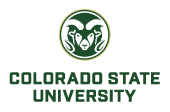
Colorado State University

Founded in 1870 as the Colorado Agricultural College, Colorado State University is now among the nation’s leading research universities. Located in Fort Collins, CSU currently enrolls about 22,650 undergraduate students, 4,100 graduate students and 550 Professional Veterinary Medicine students, and has more than 1,800 faculty members working in eight colleges. More information is available at www.colostate.edu.
Links
Displaying 181 - 200 of 368 articles

A food historian explains how the popular boxed dinner played an important role in kitchen science, wars and women’s liberation.

The COVID-19 pandemic is interrupting scientific field work across North America, leaving blank spots in important data sets and making it harder to track ecological change.

Kalender Babilonia telah diturunkan dari peradaban ke peradaban.

Yeast is a single-celled organism that’s everywhere around us. Understanding how yeast works can help you make better bread and appreciate this old friend of humanity.

Pour développer rapidement un vaccin contre le coronavirus, des technologies d’avant-garde qui n’ont pas encore été testées à grande échelle sont explorées.

In the search for a rapid COVID-19 vaccine, researchers are modifying a method using the chemical riboflavin now used to prevent disease transmission during blood transfusions.

Un repaso experto por los distintos métodos para crear una vacuna, cómo se aplican en la búsqueda de una para el Coronavirus y cuáles son los plazos, las ventajas y problemas de cada método.

Wild animals and animal parts are bought and sold worldwide, often illegally. This multibillion-dollar industry is pushing species to extinction, fueling crime and spreading disease.

Under pressure to develop a coronavirus vaccine, researchers have turned to protein synthesis, genetics and hybrid viruses. It is likely a mix of these approaches will be used to fight the coronavirus.

Un economista especializado en desigualdad explica cómo un ingreso mínimo garantizado es justo lo que necesitan los trabajadores de bajos salarios y la economía estadounidense.

Different demographics are more or less vulnerable to serious complications from the coronavirus. A virologist explains the aging-related changes in how immune systems work that are to blame.

An economist specializing in inequality explains how a basic income guarantee is just what low-wage workers and the economy need.

An economics professor investigates why college men are more likely to push back when they don’t get the grades they want.

North America’s prairies once were home to millions of wild animals. Today, most of that land is farmed or developed, but some grasslands have never been plowed and could be rewilded.

Every Democratic presidential candidate plans to raise taxes on wealthier Americans and corporations, but they differ in how to get there.

Storing more carbon in soil helps slow climate change and makes croplands more productive. But there are two kinds of soil carbon that are both important, but function very differently.

In the real world, new diseases emerge from complex environments. To learn more about how, scientists set up whole artificial ecosystems in the lab, instead of focusing on just one factor at a time.

A new look at detailed data about Civil War skirmishes along the Mississippi River reveals another key to the Union’s victory.

Mayflies and stone flies are extremely vulnerable to water pollution, which has implications for the larger food chain.

Puerto Rico’s January earthquakes came after many foreshocks and have been followed by numerous aftershocks. Scientists are studying these sequences to improve earthquake forecasting.
